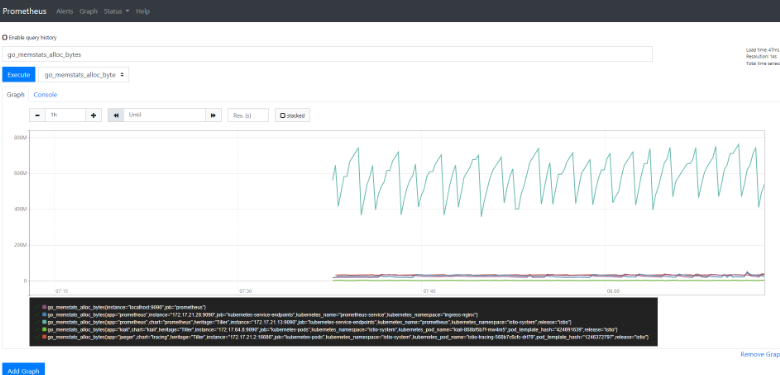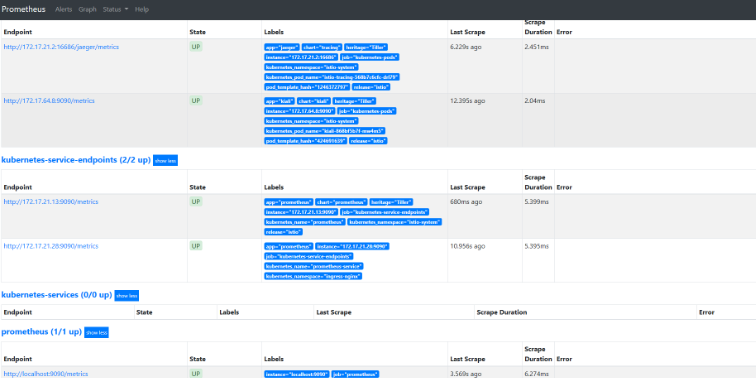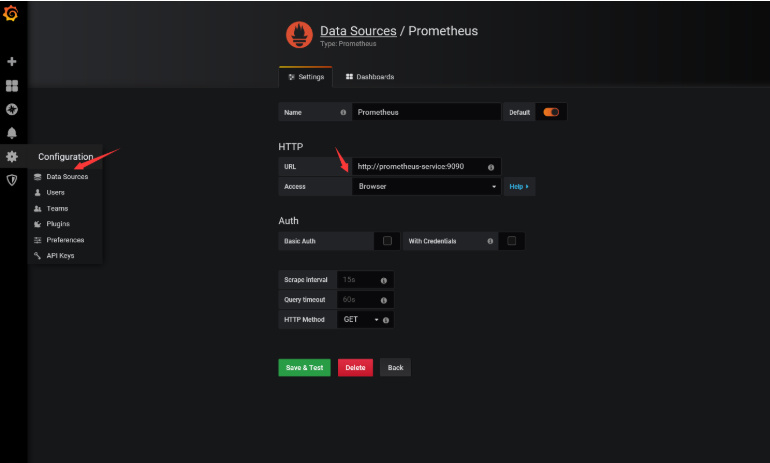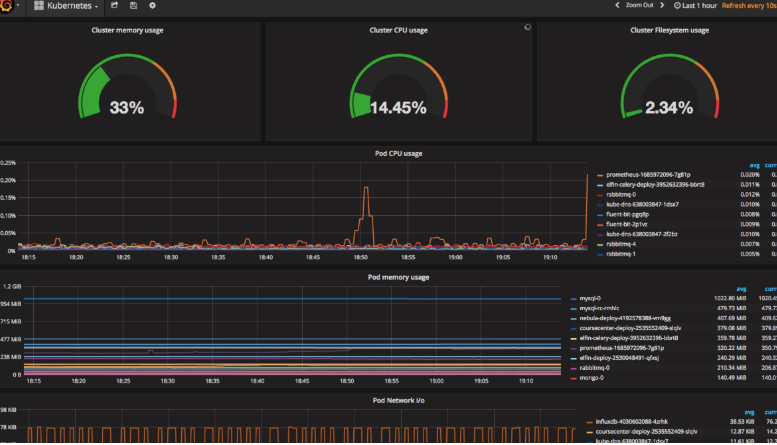Prometheus神器之监控K8s集群
Prometheus 简介
Prometheus是SoundCloud开源的一款开源软件。它的实现参考了Google内部的监控实现,与源自Google的Kubernetes结合起来非常合适。另外相比influxdb的方案,性能更加突出,而且还内置了报警功能。它针对大规模的集群环境设计了拉取式的数据采集方式,你只需要在你的应用里面实现一个metrics接口,然后把这个接口告诉Prometheus就可以完成数据采集了。
安装Prometheus
首先我们使用ConfigMap的形式来设置Prometheus的配置文件,如下
apiVersion: v1
kind: ConfigMap
metadata:
name: prometheus-configuration
labels:
app.kubernetes.io/name: prometheus
app.kubernetes.io/part-of: ingress-nginx
name: prometheus-configuration
namespace: ingress-nginx
data:
prometheus.yml: |-
global:
scrape_interval: 10s
scrape_configs:
- job_name: 'ingress-nginx-endpoints'
kubernetes_sd_configs:
- role: pod
namespaces:
names:
- ingress-nginx
relabel_configs:
- source_labels: [__meta_kubernetes_pod_annotation_prometheus_io_scrape]
action: keep
regex: true
- source_labels: [__meta_kubernetes_pod_annotation_prometheus_io_scheme]
action: replace
target_label: __scheme__
regex: (https?)
- source_labels: [__meta_kubernetes_pod_annotation_prometheus_io_path]
action: replace
target_label: __metrics_path__
regex: (.+)
- source_labels: [__address__, __meta_kubernetes_pod_annotation_prometheus_io_port]
action: replace
target_label: __address__
regex: ([^:]+)(?::\d+)?;(\d+)
replacement: $1:$2
- source_labels: [__meta_kubernetes_service_name]
regex: prometheus-server
action: drop
---
将以上配置文件保存为configuration.yaml,然后执行命令:
$ kubectl apply -f configuration.yaml
namespace "ingress-nginx" created
configmap "prometheus-configuration" created
通过Deployment部署Prometheus,yaml文件如下:
---
apiVersion: rbac.authorization.k8s.io/v1beta1
kind: ClusterRole
metadata:
name: prometheus
rules:
- apiGroups: [""] # "" indicates the core API group
resources:
- nodes
- nodes/proxy
- services
- endpoints
- pods
verbs:
- get
- watch
- list
- apiGroups:
- extensions
resources:
- ingresses
verbs:
- get
- watch
- list
- nonResourceURLs: ["/metrics"]
verbs:
- get
---
apiVersion: v1
kind: ServiceAccount
metadata:
name: prometheus
namespace: ingress-nginx
labels:
app: prometheus
---
apiVersion: rbac.authorization.k8s.io/v1beta1
kind: ClusterRoleBinding
metadata:
name: prometheus
subjects:
- kind: ServiceAccount
name: prometheus
namespace: ingress-nginx
roleRef:
kind: ClusterRole
name: prometheus
apiGroup: rbac.authorization.k8s.io
---
apiVersion: v1
kind: ConfigMap
metadata:
name: prometheus-conf
namespace: ingress-nginx
labels:
app: prometheus
data:
prometheus.yml: |-
# my global config
global:
scrape_interval: 15s # Set the scrape interval to every 15 seconds. Default is every 1 minute.
evaluation_interval: 15s # Evaluate rules every 15 seconds. The default is every 1 minute.
# scrape_timeout is set to the global default (10s).
# Alertmanager configuration
alerting:
alertmanagers:
- static_configs:
- targets:
# - alertmanager:9093
# Load rules once and periodically evaluate them according to the global 'evaluation_interval'.
rule_files:
# - "first_rules.yml"
# - "second_rules.yml"
# A scrape configuration containing exactly one endpoint to scrape:
# Here it's Prometheus itself.
scrape_configs:
# The job name is added as a label `job=<job_name>` to any timeseries scraped from this config.
- job_name: 'prometheus'
# metrics_path defaults to '/metrics'
# scheme defaults to 'http'.
static_configs:
- targets: ['localhost:9090']
- job_name: 'grafana'
static_configs:
- targets:
- 'grafana.ingress-nginx:3000'
- job_name: 'kubernetes-apiservers'
kubernetes_sd_configs:
- role: endpoints
# Default to scraping over https. If required, just disable this or change to
# `http`.
scheme: https
# This TLS & bearer token file config is used to connect to the actual scrape
# endpoints for cluster components. This is separate to discovery auth
# configuration because discovery & scraping are two separate concerns in
# Prometheus. The discovery auth config is automatic if Prometheus runs inside
# the cluster. Otherwise, more config options have to be provided within the
# <kubernetes_sd_config>.
tls_config:
ca_file: /var/run/secrets/kubernetes.io/serviceaccount/ca.crt
# If your node certificates are self-signed or use a different CA to the
# master CA, then disable certificate verification below. Note that
# certificate verification is an integral part of a secure infrastructure
# so this should only be disabled in a controlled environment. You can
# disable certificate verification by uncommenting the line below.
#
# insecure_skip_verify: true
bearer_token_file: /var/run/secrets/kubernetes.io/serviceaccount/token
# Keep only the default/kubernetes service endpoints for the https port. This
# will add targets for each API server which Kubernetes adds an endpoint to
# the default/kubernetes service.
relabel_configs:
- source_labels: [__meta_kubernetes_namespace, __meta_kubernetes_service_name, __meta_kubernetes_endpoint_port_name]
action: keep
regex: default;kubernetes;https
# Scrape config for nodes (kubelet).
#
# Rather than connecting directly to the node, the scrape is proxied though the
# Kubernetes apiserver. This means it will work if Prometheus is running out of
# cluster, or can't connect to nodes for some other reason (e.g. because of
# firewalling).
- job_name: 'kubernetes-nodes'
# Default to scraping over https. If required, just disable this or change to
# `http`.
scheme: https
# This TLS & bearer token file config is used to connect to the actual scrape
# endpoints for cluster components. This is separate to discovery auth
# configuration because discovery & scraping are two separate concerns in
# Prometheus. The discovery auth config is automatic if Prometheus runs inside
# the cluster. Otherwise, more config options have to be provided within the
# <kubernetes_sd_config>.
tls_config:
ca_file: /var/run/secrets/kubernetes.io/serviceaccount/ca.crt
bearer_token_file: /var/run/secrets/kubernetes.io/serviceaccount/token
kubernetes_sd_configs:
- role: node
relabel_configs:
- action: labelmap
regex: __meta_kubernetes_node_label_(.+)
- target_label: __address__
replacement: kubernetes.default.svc:443
- source_labels: [__meta_kubernetes_node_name]
regex: (.+)
target_label: __metrics_path__
replacement: /api/v1/nodes/${1}/proxy/metrics
# Scrape config for Kubelet cAdvisor.
#
# This is required for Kubernetes 1.7.3 and later, where cAdvisor metrics
# (those whose names begin with 'container_') have been removed from the
# Kubelet metrics endpoint. This job scrapes the cAdvisor endpoint to
# retrieve those metrics.
#
# In Kubernetes 1.7.0-1.7.2, these metrics are only exposed on the cAdvisor
# HTTP endpoint; use "replacement: /api/v1/nodes/${1}:4194/proxy/metrics"
# in that case (and ensure cAdvisor's HTTP server hasn't been disabled with
# the --cadvisor-port=0 Kubelet flag).
#
# This job is not necessary and should be removed in Kubernetes 1.6 and
# earlier versions, or it will cause the metrics to be scraped twice.
- job_name: 'kubernetes-cadvisor'
# Default to scraping over https. If required, just disable this or change to
# `http`.
scheme: https
# This TLS & bearer token file config is used to connect to the actual scrape
# endpoints for cluster components. This is separate to discovery auth
# configuration because discovery & scraping are two separate concerns in
# Prometheus. The discovery auth config is automatic if Prometheus runs inside
# the cluster. Otherwise, more config options have to be provided within the
# <kubernetes_sd_config>.
tls_config:
ca_file: /var/run/secrets/kubernetes.io/serviceaccount/ca.crt
bearer_token_file: /var/run/secrets/kubernetes.io/serviceaccount/token
kubernetes_sd_configs:
- role: node
relabel_configs:
- action: labelmap
regex: __meta_kubernetes_node_label_(.+)
- target_label: __address__
replacement: kubernetes.default.svc:443
- source_labels: [__meta_kubernetes_node_name]
regex: (.+)
target_label: __metrics_path__
replacement: /api/v1/nodes/${1}/proxy/metrics/cadvisor
# Scrape config for service endpoints.
#
# The relabeling allows the actual service scrape endpoint to be configured
# via the following annotations:
#
# * `prometheus.io/scrape`: Only scrape services that have a value of `true`
# * `prometheus.io/scheme`: If the metrics endpoint is secured then you will need
# to set this to `https` & most likely set the `tls_config` of the scrape config.
# * `prometheus.io/path`: If the metrics path is not `/metrics` override this.
# * `prometheus.io/port`: If the metrics are exposed on a different port to the
# service then set this appropriately.
- job_name: 'kubernetes-service-endpoints'
kubernetes_sd_configs:
- role: endpoints
relabel_configs:
- source_labels: [__meta_kubernetes_service_annotation_prometheus_io_scrape]
action: keep
regex: true
- source_labels: [__meta_kubernetes_service_annotation_prometheus_io_scheme]
action: replace
target_label: __scheme__
regex: (https?)
- source_labels: [__meta_kubernetes_service_annotation_prometheus_io_path]
action: replace
target_label: __metrics_path__
regex: (.+)
- source_labels: [__address__, __meta_kubernetes_service_annotation_prometheus_io_port]
action: replace
target_label: __address__
regex: ([^:]+)(?::\d+)?;(\d+)
replacement: $1:$2
- action: labelmap
regex: __meta_kubernetes_service_label_(.+)
- source_labels: [__meta_kubernetes_namespace]
action: replace
target_label: kubernetes_namespace
- source_labels: [__meta_kubernetes_service_name]
action: replace
target_label: kubernetes_name
# Example scrape config for probing services via the Blackbox Exporter.
#
# The relabeling allows the actual service scrape endpoint to be configured
# via the following annotations:
#
# * `prometheus.io/probe`: Only probe services that have a value of `true`
- job_name: 'kubernetes-services'
metrics_path: /probe
params:
module: [http_2xx]
kubernetes_sd_configs:
- role: service
relabel_configs:
- source_labels: [__meta_kubernetes_service_annotation_prometheus_io_probe]
action: keep
regex: true
- source_labels: [__address__]
target_label: __param_target
- target_label: __address__
replacement: blackbox-exporter.example.com:9115
- source_labels: [__param_target]
target_label: instance
- action: labelmap
regex: __meta_kubernetes_service_label_(.+)
- source_labels: [__meta_kubernetes_namespace]
target_label: kubernetes_namespace
- source_labels: [__meta_kubernetes_service_name]
target_label: kubernetes_name
# Example scrape config for probing ingresses via the Blackbox Exporter.
#
# The relabeling allows the actual ingress scrape endpoint to be configured
# via the following annotations:
#
# * `prometheus.io/probe`: Only probe services that have a value of `true`
- job_name: 'kubernetes-ingresses'
metrics_path: /probe
params:
module: [http_2xx]
kubernetes_sd_configs:
- role: ingress
relabel_configs:
- source_labels: [__meta_kubernetes_ingress_annotation_prometheus_io_probe]
action: keep
regex: true
- source_labels: [__meta_kubernetes_ingress_scheme,__address__,__meta_kubernetes_ingress_path]
regex: (.+);(.+);(.+)
replacement: ${1}://${2}${3}
target_label: __param_target
- target_label: __address__
replacement: blackbox-exporter.example.com:9115
- source_labels: [__param_target]
target_label: instance
- action: labelmap
regex: __meta_kubernetes_ingress_label_(.+)
- source_labels: [__meta_kubernetes_namespace]
target_label: kubernetes_namespace
- source_labels: [__meta_kubernetes_ingress_name]
target_label: kubernetes_name
# Example scrape config for pods
#
# The relabeling allows the actual pod scrape endpoint to be configured via the
# following annotations:
#
# * `prometheus.io/scrape`: Only scrape pods that have a value of `true`
# * `prometheus.io/path`: If the metrics path is not `/metrics` override this.
# * `prometheus.io/port`: Scrape the pod on the indicated port instead of the
# pod's declared ports (default is a port-free target if none are declared).
- job_name: 'kubernetes-pods'
kubernetes_sd_configs:
- role: pod
relabel_configs:
- source_labels: [__meta_kubernetes_pod_annotation_prometheus_io_scrape]
action: keep
regex: true
- source_labels: [__meta_kubernetes_pod_annotation_prometheus_io_path]
action: replace
target_label: __metrics_path__
regex: (.+)
- source_labels: [__address__, __meta_kubernetes_pod_annotation_prometheus_io_port]
action: replace
regex: ([^:]+)(?::\d+)?;(\d+)
replacement: $1:$2
target_label: __address__
- action: labelmap
regex: __meta_kubernetes_pod_label_(.+)
- source_labels: [__meta_kubernetes_namespace]
action: replace
target_label: kubernetes_namespace
- source_labels: [__meta_kubernetes_pod_name]
action: replace
target_label: kubernetes_pod_name
---
apiVersion: v1
kind: ConfigMap
metadata:
name: prometheus-rules
namespace: ingress-nginx
labels:
app: prometheus
data:
cpu-usage.rule: |
groups:
- name: NodeCPUUsage
rules:
- alert: NodeCPUUsage
expr: (100 - (avg by (instance) (irate(node_cpu{name="node-exporter",mode="idle"}[5m])) * 100)) > 75
for: 2m
labels:
severity: "page"
annotations:
summary: "{{$labels.instance}}: High CPU usage detected"
description: "{{$labels.instance}}: CPU usage is above 75% (current value is: {{ $value }})"
---
kind: Deployment
apiVersion: apps/v1beta2
metadata:
labels:
app: prometheus
name: prometheus
namespace: ingress-nginx
spec:
replicas: 1
revisionHistoryLimit: 10
selector:
matchLabels:
app: prometheus
template:
metadata:
labels:
app: prometheus
spec:
serviceAccountName: prometheus
securityContext:
runAsUser: 65534
fsGroup: 65534
containers:
- name: prometheus
image: prom/prometheus:latest
volumeMounts:
- mountPath: /etc/prometheus/prometheus.yml
name: prometheus-conf-volume
subPath: prometheus.yml
- mountPath: /etc/prometheus/rules
name: prometheus-rules-volume
ports:
- containerPort: 9090
protocol: TCP
volumes:
- name: prometheus-conf-volume
configMap:
name: prometheus-conf
- name: prometheus-rules-volume
configMap:
name: prometheus-rules
tolerations:
- key: node-role.kubernetes.io/master
effect: NoSchedule
---
kind: Service
apiVersion: v1
metadata:
annotations:
prometheus.io/scrape: 'true'
labels:
app: prometheus
name: prometheus-service
namespace: ingress-nginx
spec:
ports:
- port: 9090
targetPort: 9090
selector:
app: prometheus
type: NodePort
将以上文件保存为prometheus.yaml,然后执行命令:
$ kubectl apply -f prometheus.yaml
clusterrole "prometheus" created
serviceaccount "prometheus" created
clusterrolebinding "prometheus" created
configmap "prometheus-conf" created
configmap "prometheus-rules" created
deployment "prometheus" created
service "prometheus-service" created
部署node-exporter,为了能够收集每个节点的信息,所以我们这里使用DaemonSet的形式部署:
kind: DaemonSet
apiVersion: apps/v1beta2
metadata:
labels:
app: node-exporter
name: node-exporter
namespace: ingress-nginx
spec:
revisionHistoryLimit: 10
selector:
matchLabels:
app: node-exporter
template:
metadata:
labels:
app: node-exporter
spec:
containers:
- name: node-exporter
image: prom/node-exporter:v0.16.0
ports:
- containerPort: 9100
protocol: TCP
name: http
hostNetwork: true
hostPID: true
tolerations:
- effect: NoSchedule
operator: Exists
---
kind: Service
apiVersion: v1
metadata:
labels:
app: node-exporter
name: node-exporter-service
namespace: ingress-nginx
spec:
ports:
- name: http
port: 9100
nodePort: 31672
protocol: TCP
type: NodePort
selector:
app: node-exporter
将以上文件保存为node-exporter.yaml,然后执行命令:
$ kubectl apply -f node-exporter.yaml
daemonset "node-exporter" created
service "node-exporter-service" created
接下来暴露服务以便可以访问Prometheus的UI界面,查看NodePort:
[root@dtdream-dtwarebase-prod-k8s-01 monitoring]# kubectl -s10.90.2.100:8080 -ningress-nginx get svc,po -owide
NAME TYPE CLUSTER-IP EXTERNAL-IP PORT(S) AGE SELECTOR
svc/node-exporter-service NodePort 10.254.208.254 <none> 9100:31672/TCP 55s app=node-exporter
svc/prometheus-service NodePort 10.254.187.175 <none> 9090:25759/TCP 3m app=prometheus
NAME READY STATUS RESTARTS AGE IP NODE
po/node-exporter-b47ch 1/1 Running 0 54s 10.90.2.102 10.90.2.102
po/node-exporter-q88pp 1/1 Running 0 54s 10.90.2.100 10.90.2.100
po/prometheus-7b7fd77c44-7cf6z 1/1 Running 0 3m 172.17.21.28 10.90.2.101
然后用浏览器访问http://10.90.2.101:9090就可以访问到Prometheus的界面了。

可以切换到Status下面的targets查看我们采集的数据是否正常:

可以根据targets下面的提示信息对采集失败的数据进行修正。
查询监控数据
Prometheus提供了API的方式进行数据查询,同样可以使用query语言进行复杂的查询任务,在上面的WEB界面上提供了基本的查询和图形化的展示功能。
比如查询每个POD的CPU使用情况,查询条件如下:
sum by (pod_name)( rate(container_cpu_usage_seconds_total{image!="", pod_name!=""}[1m] ) )
注意其中的pod_name和image要根据自己采集的数据进行区分。
安装Grafana
Prometheus以及获取到了我们采集的数据,现在我们需要一个更加强大的图标展示工具,毫无疑问选择grafana,同样的,在Kubernetes环境下面进行安装,yaml文件如下:
apiVersion: extensions/v1beta1
kind: Deployment
metadata:
labels:
app.kubernetes.io/name: grafana
app.kubernetes.io/part-of: ingress-nginx
name: grafana
namespace: ingress-nginx
spec:
selector:
matchLabels:
app.kubernetes.io/name: grafana
app.kubernetes.io/part-of: ingress-nginx
strategy:
rollingUpdate:
maxSurge: 1
maxUnavailable: 1
type: RollingUpdate
template:
metadata:
labels:
app.kubernetes.io/name: grafana
app.kubernetes.io/part-of: ingress-nginx
spec:
containers:
- image: grafana/grafana
name: grafana
ports:
- containerPort: 3000
protocol: TCP
resources:
limits:
cpu: 500m
memory: 2500Mi
requests:
cpu: 100m
memory: 100Mi
volumeMounts:
- mountPath: /var/lib/grafana
name: data
restartPolicy: Always
volumes:
- emptyDir: {}
name: data
---
apiVersion: v1
kind: Service
metadata:
name: grafana
namespace: ingress-nginx
labels:
app.kubernetes.io/name: grafana
app.kubernetes.io/part-of: ingress-nginx
spec:
ports:
- port: 3000
protocol: TCP
targetPort: 3000
selector:
app.kubernetes.io/name: grafana
app.kubernetes.io/part-of: ingress-nginx
type: NodePort
---
将以上文件保存为grafana.yaml,然后执行命令:
$ kubectl apply -f grafana.yaml
deployment "grafana" created
service "grafana" created
可以选择使用ingress将服务暴露在外网进行访问。 访问grafanaWEB界面,我这里就直接使用的Nodeport。
查看grafana访问端口
$ kubectl -ningress-nginx get svc,po|grep grafana
svc/grafana NodePort 10.254.86.182 <none> 3000:7006/TCP 2m
po/grafana-85fbffb76f-x6hqw 1/1 Running 0 2m
访问http://10.90.2.101:7006

将我们上面的Prometheus添加到grafana数据源中去。

然后添加我们的Dashboard,可以使用https://grafana.com/dashboards/162,可以下载该页面的dashboard的json文件,然后直接导入到grafana中去,但是需要注意其中的一些参数,需要根据prometheus中采集到实际数据进行填写,比如我们这里采集到容器名是name,而不是io_kubernetes_container_name,最终展示界面如下:

上面用的yaml文件可以到github上查看https://github.com/jcops/k8s-yaml/tree/master/monitoring
欢迎您关注程序员同行者订阅号,程序员同行者是一个技术分享平台,主要是运维自动化开发:linux、python、django、saltstack、redis、golang、docker、kubernetes、vue等经验分享及经验交流。
趁现在,关注我们
牛人并不可怕,可怕的是牛人比我们还努力!
如果您觉得不错,请别忘了转发、分享、点赞让更多的人去学习, 您的举手之劳,就是对小编最好的支持,非常感谢!

Prometheus神器之监控K8s集群的更多相关文章
- 基于prometheus监控k8s集群
本文建立在你已经会安装prometheus服务的基础之上,如果你还不会安装,请参考:prometheus多维度监控容器 如果你还没有安装库k8s集群,情参考: 从零开始搭建基于calico的kuben ...
- Kubernetes之利用prometheus监控K8S集群
prometheus它是一个主动拉取的数据库,在K8S中应该展示图形的grafana数据实例化要保存下来,使用分布式文件系统加动态PV,但是在本测试环境中使用本地磁盘,安装采集数据的agent使用Da ...
- Prometheus 监控K8S集群资源监控
Prometheus 监控K8S集群中Pod 目前cAdvisor集成到了kubelet组件内,可以在kubernetes集群中每个启动了kubelet的节点使用cAdvisor提供的metrics接 ...
- 如何使用helm优雅安装prometheus-operator,并监控k8s集群微服务
前言:随着云原生概念盛行,对于容器.服务.节点以及集群的监控变得越来越重要.Prometheus 作为 Kubernetes 监控的事实标准,有着强大的功能和良好的生态.但是它不支持分布式,不支持数据 ...
- shell脚本监控k8s集群job状态,若出现error通过触发阿里云的进程监控报警
#!/bin/bash while [ 1 ] do job_error_no=`kubectl get pod -n weifeng |grep -i "job"|grep -c ...
- 如何用prometheus监控k8s集群中业务pod的metrics
一般,我们从网上看到的帖子和资料, 都是用prometheus监控k8s的各项资源, 如api server, namespace, pod, node等. 那如果是自己的业务pod上的自定义metr ...
- 使用Prometheus和Grafana监控nacos集群
官方文档:https://nacos.io/zh-cn/docs/monitor-guide.html 按照部署文档搭建好Nacos集群 配置application.properties文件,暴露me ...
- 使用Prometheus和Grafana监控RabbitMQ集群 (使用RabbitMQ自带插件)
配置RabbitMQ集群 官方文档:https://www.rabbitmq.com/prometheus.html#quick-start 官方github地址:https://github.com ...
- 使用Prometheus和Grafana监控emqx集群
以 Prometheus为例: emqx_prometheus 支持将数据推送至 Pushgateway 中,然后再由 Promethues Server 拉取进行存储. 注意:emqx_promet ...
随机推荐
- css兄弟选择器,+ ~选择器的区别
壹 ❀ 引 实习生在写搜索框下拉提示时,遇到了不知道怎么解决的问题,所以来问我.效果不难,鼠标选中输入框(focus)时,展示搜索关键字相关提示,看了眼dom结构是这样的: 在她的理解里面,选中父元 ...
- centos7之firewalld防火墙的配置与使用
firewalld是centos7开始提供的管理防火墙工具,提供了一个动态管理的防火墙,当然低层仍然调用的是 netfilter . 一.区域(zone)firewalld将网卡对应到不同的区域(zo ...
- windows 安装使用jupyter及 基础配置
jupyter 是什么Jupyter Notebooks 是一个交互式笔记本,支持运行 40 多种编程语言,它的本质是一个 开源的 Web 应用程序,我们可以将其用于创建和共享代码与文档,他可以支持实 ...
- 安装Keepalived namespaces.c:187: error: ‘SYS_setns’ undeclared (first use in this function)
错误信息 namespaces.c: In function ‘setns’: namespaces.c:: error: ‘SYS_setns’ undeclared (first use in t ...
- C# copy files from source directory to destination file and rename repeated files and does not override
static void CopyFiles() { string sourceDir = @"D:\C\ll"; string destDir = @"D:\LL&quo ...
- 使用 FiddlerCore 自定义 HTTP/HTTPS 网络代理
Fiddler 是个很好用的网络请求查看与调试工具,还可以写插件来扩展其功能. Fiddler 插件开发,使用 WPF 作为 UI 控件 - J.晒太阳的猫 - 博客园 但部分场景下,需要自定义很多网 ...
- Redis哨兵模式大key优化
目前,Redis哨兵模式,内存资源有限,有很多key大于500M,性能待优化.需要迁移至Redis-cluster集群中. 涉及到的key如下: 0,hash,duser_record, ...
- ECAMScript中的let和const
let与const命令都是用来在js中声明变量的,在使用上与var相似,但存在一些区别,下面先讲let同var的区别 let 怎么使用呢,同var一样,let 变量名 就可以声明了 区别一:其作 ...
- overflow-x:scroll失效问题解决
在移动设备上设置overflow-x:scroll,大部分机型都是展示正常的,在安卓哦5.0系统上,无论怎么样滚动条都不会生效,终于找到了解决办法: display: -webkit-box; // ...
- WebLogic任意文件上传漏洞复现与分析 -【CVE-2018-2894 】
CVE-2018-2894 漏洞影响版本:10.3.6.0, 12.1.3.0, 12.2.1.2, 12.2.1.3 下载地址:http://download.oracle.com/otn/nt/m ...
